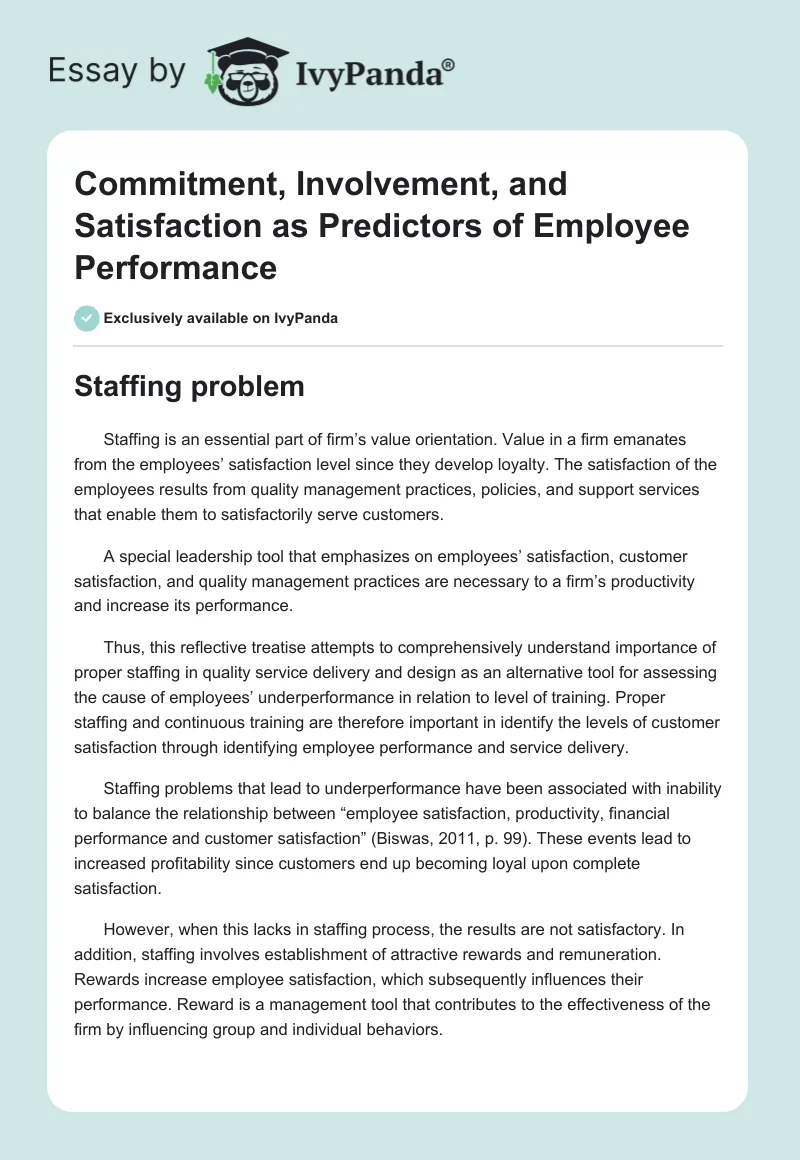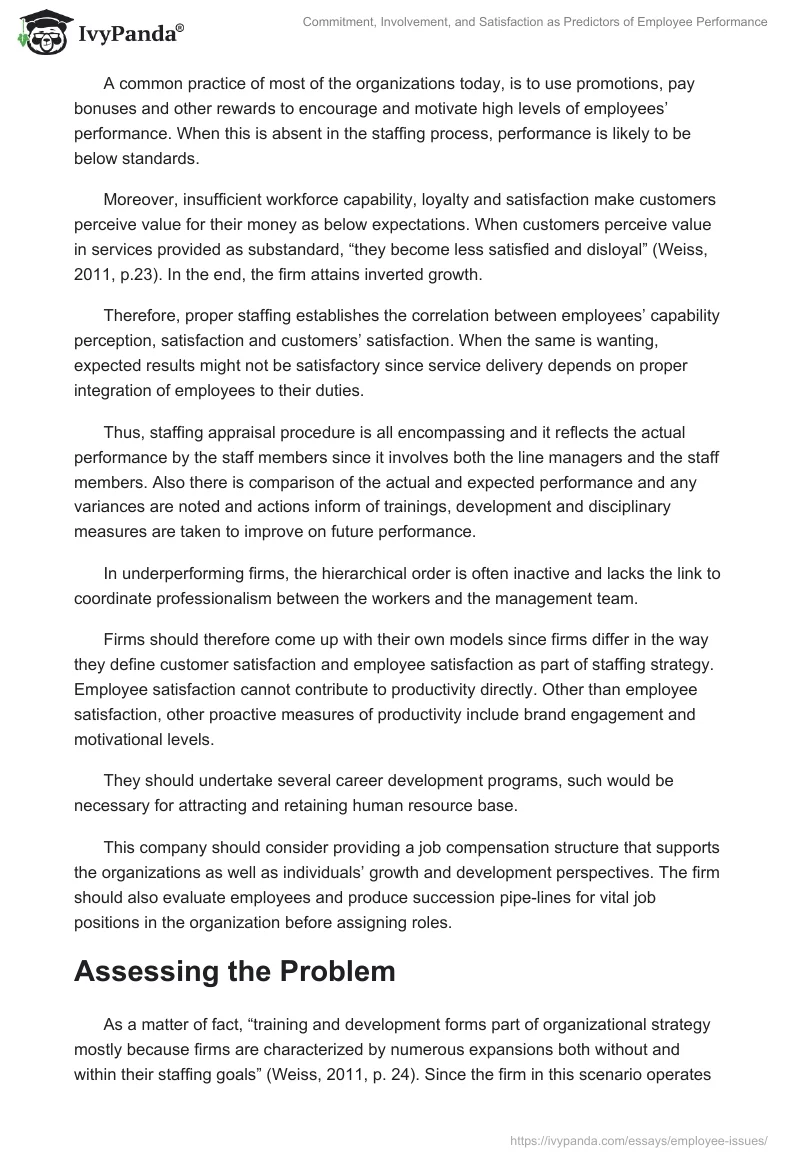Staffing problem
Staffing is an essential part of firm’s value orientation. Value in a firm emanates from the employees’ satisfaction level since they develop loyalty. The satisfaction of the employees results from quality management practices, policies, and support services that enable them to satisfactorily serve customers.
A special leadership tool that emphasizes on employees’ satisfaction, customer satisfaction, and quality management practices are necessary to a firm’s productivity and increase its performance.
Thus, this reflective treatise attempts to comprehensively understand importance of proper staffing in quality service delivery and design as an alternative tool for assessing the cause of employees’ underperformance in relation to level of training. Proper staffing and continuous training are therefore important in identify the levels of customer satisfaction through identifying employee performance and service delivery.
Staffing problems that lead to underperformance have been associated with inability to balance the relationship between “employee satisfaction, productivity, financial performance and customer satisfaction” (Biswas, 2011, p. 99). These events lead to increased profitability since customers end up becoming loyal upon complete satisfaction.
However, when this lacks in staffing process, the results are not satisfactory. In addition, staffing involves establishment of attractive rewards and remuneration. Rewards increase employee satisfaction, which subsequently influences their performance. Reward is a management tool that contributes to the effectiveness of the firm by influencing group and individual behaviors.
A common practice of most of the organizations today, is to use promotions, pay bonuses and other rewards to encourage and motivate high levels of employees’ performance. When this is absent in the staffing process, performance is likely to be below standards.
Moreover, insufficient workforce capability, loyalty and satisfaction make customers perceive value for their money as below expectations. When customers perceive value in services provided as substandard, “they become less satisfied and disloyal” (Weiss, 2011, p.23). In the end, the firm attains inverted growth.
Therefore, proper staffing establishes the correlation between employees’ capability perception, satisfaction and customers’ satisfaction. When the same is wanting, expected results might not be satisfactory since service delivery depends on proper integration of employees to their duties.
Thus, staffing appraisal procedure is all encompassing and it reflects the actual performance by the staff members since it involves both the line managers and the staff members. Also there is comparison of the actual and expected performance and any variances are noted and actions inform of trainings, development and disciplinary measures are taken to improve on future performance.
In underperforming firms, the hierarchical order is often inactive and lacks the link to coordinate professionalism between the workers and the management team.
Firms should therefore come up with their own models since firms differ in the way they define customer satisfaction and employee satisfaction as part of staffing strategy. Employee satisfaction cannot contribute to productivity directly. Other than employee satisfaction, other proactive measures of productivity include brand engagement and motivational levels.
They should undertake several career development programs, such would be necessary for attracting and retaining human resource base.
This company should consider providing a job compensation structure that supports the organizations as well as individuals’ growth and development perspectives. The firm should also evaluate employees and produce succession pipe-lines for vital job positions in the organization before assigning roles.
Assessing the Problem
As a matter of fact, “training and development forms part of organizational strategy mostly because firms are characterized by numerous expansions both without and within their staffing goals” (Weiss, 2011, p. 24). Since the firm in this scenario operates in a volatile environment, training and development will facilitate comprehensive analysis of potential members of the staff.
Thus, this will facilitate the goals aimed at remaining competitive in labor management and quality in service delivery. Therefore, through training and development, it will be possible for the firm to improve on staffing selection procedures and testing.
To achieve this, empowerment and leadership styles could be used strategically to increase employees’ job satisfaction and subsequently performance. If employees feel satisfied, it is expected that the customers would also get satisfied. Training would further analyze the effects of empowering employees on customers’ satisfaction and service quality and establish a quantifiable correlation.
A planned change approach would be required with the initiation and implementation of change being driven by management with the aid of a human resources expert. Magnitude of change is quantum as large changes involving culture, structure and strategy of the company is required.
Transformational change “is a relatively new count to organizational change” (Biswas, 2011, p. 101). It is concerned with drastic change and is fundamentally about altering the way that the organization is perceived both internally and externally as well as how it functions.
Reflecting on the previous scenario, it is apparent that underperformance by the employees is as a result of improper staffing conditions and partial inconsistency in training. However, it is clear that the same can be reversed by designing a proper staffing strategy that is inclusive of employee motivation, training, and qualification before assigning relevant duties.
References
Weiss, W. (2011). Building morale, motivating, and empowering employees. Supervision Journal, 72(9), 23-26.
Biswas, S. (2011). Commitment, involvement, and satisfaction as predictors of employee performance. South Asian Journal of Management, 18(2), 92-107.


